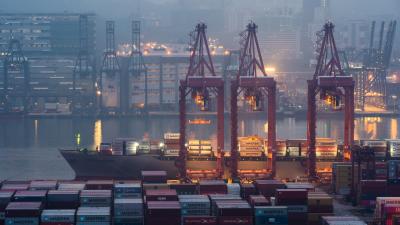A global, multi-stakeholder initiative has issued new guidance to help port leaders build long-term resilience in the face of climate change.
Resilience4Ports (R4P), led by the International Coalition for Sustainable Infrastructure (ICSI) and supported by Arup, UN Climate Change High-Level Champions, Lloyd's Register and Lloyd’s Register Foundation, has unveiled its Port Decision Makers Guide to Climate Risk Assessment (CRA) at COP30.
The backbone of global and local economies, ports are at the forefront of the climate crisis and often feel its effects most acutely. According to an analysis from the Environmental Defense Fund, climate-related port disruptions cost the global economy an estimated $7-10 billion annually, with projections suggesting this could rise to $25-30 billion by 2100 without adequate adaptation measures.
In response to the urgent need for action, the new report offers practical guidance to ensure port leaders can better understand and implement Climate Risk Assessments (CRAs), a structured process designed to identify, evaluate and prioritise risks associated with climate change, from rising sea levels and flooding to extreme wind or temperatures. The tool covers physical assets, as well as digital systems crucial to port functionality, taking a holistic view of the entire port ecosystem.
Dr Darshana Godaliyadde, Director of Resilience4Ports, said: “The resilience of global port systems is under threat, and the urgency of the situation cannot be understated.
“Climate change-related risks have the potential to completely shut down parts of the global logistics network, the financial, social and environmental consequences of which would be dramatic on both a local and international scale. That’s why we believe understanding and managing these risks will be key to catalyse momentum across the industry and build long-term sustainability.
“Calls for port actors to mobilise are growing, but all too often there is limited funding or tools available to empower them to make meaningful, long-lasting changes. While the CRAs won’t stop sea levels from rising, they are a vital tool for decision-makers to assess the risk and build a roadmap to address these pressing challenges throughout the port value chain. Our guidance was designed to provide actionable, concrete steps to building robust CRAs, so we hope port leaders worldwide will take advantage of it to understand and manage climate risks while also accessing appropriate climate finance mechanisms.”
Thomas Thune Andersen, Chairman, Lloyd's Register Foundation, said: “Ports are a vital element of the trade ecosystem, facilitating the global supply of goods to millions of people around the world. Due to their proximity to both land and ocean, ports are under immense pressure from climate change.
“Higher temperatures, rising sea levels and more frequent and severe weather patterns will increasingly expose vulnerabilities in port infrastructure, particularly in small island developing states and emerging ocean economies, where the impact of these changes will be felt hardest. Overcoming these challenges will require significant investment, mobilising a vast amount of resources to adapt our ports and build resilience into our supply chains.
“The Resilience4Ports initiative is playing a vital role in this transition, convening key actors across the port ecosystem to work together with a collaborative mindset, rather than a competitive one. The Climate Risk Assessment Guidance, launched at COP30, is this vision in practice. It will help address capacity gaps for decision makers throughout the port value chain, providing a holistic and financeable approach to climate adaptation. Together, we can future-proof port systems and, in doing so, drive better working conditions, healthier ecosystems, and new access to capital for existing and emerging ports around the world."
Mr. Niriko Tsirenge, Director General, SMMC Toamasina & Port Authority of Vohemar (Port of Iharana) (Port Management Association of Eastern & Southern Africa - PMAESA Member) said: “As the architect of Madagascar's strategic maritime gateways, SMMC has a national responsibility to ensure our ports are resilient against climate change. This essential R4P guide provides a clear and practical framework that moves resilience from theory to action. We are proud to have contributed and are committed to using this tool to safeguard our infrastructure, secure the nation's supply chains, and support Madagascar's sustainable development goals."
Mrs. Hasnita Binti Mohd Hanapiah, General Manager, Kuantan Port Authority, Malaysia said: “Kuantan Port remains committed to embedding sustainability and resilience as core principles in our port operations and development strategy. Our focus on energy efficiency, nature-positive engineering, renewable energy, and the advancement of Carbon Capture, Utilisation and Storage (CCUS) initiatives reflects our dedication to achieving long-term environmental and operational excellence.
In alignment with the objectives of the R4P Call to Action, we recognise the strategic importance of ports in addressing climate risks through a structured Climate Risk Assessment (CRA) and enhancing global supply chain resilience. Kuantan Port continues to strengthen its capacity through innovation, environmental stewardship, and adaptive planning to ensure business continuity and sustainable growth in the face of a changing climate.
We are honoured to contribute to this collective global effort and remain steadfast in supporting the transition toward a low-carbon, climate-resilient, and sustainable maritime sector.”
To download the guidance, visit the International Coalition for Sustainable Infrastructure website.



